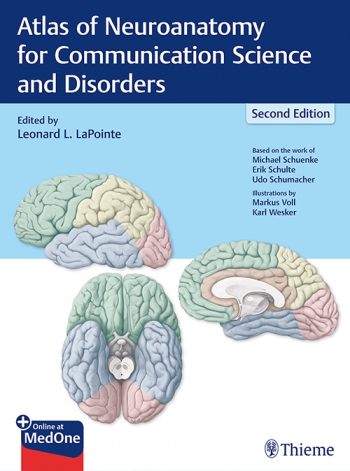
A beautifully illustrated atlas that provides robust speech-language pathology and audiology learning tools
Atlas of Neuroanatomy for Communication Science and Disorders, Second Edition, is based on the award-winning
textbook Atlas of Anatomy and the work of Michael Schuenke, Erik Schulte, and Udo Schumacher. The updated text
reflects advances in neuroscience and invaluable insights from Leonard L. LaPointe, one of the foremost teachers
and practitioners in the field of brain-based communication disorders today. The book features beautiful illustrations
from the recently published second edition of the Schuenke atlases and new content on cognition, higher cortical
function, the spinal cord, structural damage, and clinic-pathological effects.
Divided into seven chapters, the book is presented in a logical framework, starting with a concise, illustrated
overview of anatomy of the brain and nervous system. This approach ensures mastery of introductory concepts
before readers move on to more advanced material. The text covers traditional acquired speech-language conditions
such as aphasia and neuromotor speech disorders, cognition and swallowing disorders, communication impairments
caused by traumatic brain injury, multisystem blast injuries, and degenerative disorders of the nervous system.
Key Highlights
• More than 450 exquisitely rendered full-color illustrations delineate basic anatomy and physiology, multiple
visual perspectives, and impacted and interrelated body structures
• Descriptive legends and text bridge the gap between neuroanatomic principles and clinical applications
• Tables, charts, and concise text clearly detail the role of anatomical structures in normal communication and what
happens when they dysfunction
This remarkable atlas is essential reading for graduate and undergraduate students in speech-language pathology,
audiology, and communication sciences. It will also greatly benefit clinicians who need to understand the crucial
connection between neuroanatomy and functional systems when treating people with communication disorders. It
should be on the bookshelf of every practicing clinician or student who deals with brain-based disorders.
This book includes complimentary access to a digital copy on https://medone.thieme.com.
1. Introduction and Brain Basics
2. General Anatomical Concepts
2.1 The Human Body(Proportions, Surface Areas, and Body Weights)
2.2 The Structural Design of the Human Body
2.3 Body Surface Anatomy
2.4 Terms of Lacation and Direction, Cardianl Planes and Axes
2.5 Body Surface Contours and Palpable Bony Prominences
2.6 Topography and Structure of the Nervous System
2.7 Cells of the Nervous System
2.8 Differences between the Central and Peripheral Nervous Systems
3. Head, Skull, Neck Anatomy
3.1 Skull, Lateral View
3.2 Skull, Anterior View
3.3 Skull, Posterior View and Cranial Sutures
3.4 Base of the Skull, External View
3.5 Overview of the Entire Nervous Sytem: Morphology and Spatial Orientation
4. Anatomy of the Brain and Nervous Systems
4.1 Brain, Macroscopic Organization
4.2 Coronal Sections: III and IV
4.3 Transverse Sections: III and IV
4.4 Sagittal Sections: IV to VI
4.5 Brain and Meninges In Situ
4.6 Meninges of the Brain and Spinal Cord
4.7 Ventricular System, Overview
4.8 Cerebrospinal Fluid, Circulation and Cisterns
4.9 Telencephalon, Development and External Structure
4.10 Neocortex, Cortical Areas
4.11 Allocortex, Overview
4.12 Allocortex: Hippocampus and Amygdala
4.13 Telencephalon: White Matter and Basal Ganglia
4.14 Diencephalon, External Structure
4.15 Diencephalon, Internal Structure
4.16 Thalamus: Thalamic Nuclei
4.17 Thalamus: Projections fo the Thalamic Nuclei
4.18 Hypothalamus
4.19 Brainstem, Organization and External Structure
4.20 Brainstem: Cranial Nerve Nuclei, Red Nucleus, and Substantia Nigra
4.21 Brainstem: Descending (Motor) and Ascending (Sensory) Tracts
4.22 Brainstem: Reticular Formation
4.23 Mesencephalon and Pons, Transverse Section
4.24 Medulla Oblongata, Transverse Section
4.25 Cerebellum, Internal Structure
4.26 Cerebellum, Simplified Functional Anatomy and Lesions
4.27 Vertebral Column and Vertebrae
4.28 Spinal Cord, Segmental Organization
4.29 Tracts of the Spianl Cord, Overview
4.30 Spinal Cord, Topography
5. Cranial Nerves
5.1 Overview of the Cranial Nerves
5.2 Cranial Nerves Most Involved in Speech Swallosing : Trigeminal (CN V), Nuclei and Distribution
5.3 Cranial Nerves Most Involved in Speech Swallosing : Trigeminal (CN V), Divisions
5.4 Cranial Nerves Most Involved in Speech Swallosing : Facial (CN VII), Nuclei and Distribution
5.5 Cranial Nerves Most Involved in Speech Swallosing : Facial (CN VII), Branches
5.6 Cranial Nerves Most Involved in Speech Swallosing : Vestibulocochlear [or Auditory-Vestivular] (CN VII)
5.7 Cranial Nerves Most Involved in Speech Swallosing : Glossopharyngeal (CN IX)
5.8 Cranial Nerves Most Involved in Speech Swallosing : Vagus (CN X)
5.9 Larynx: Topography
5.10 Endotracheal Intubation
5.11 Cranial Nerves Most Involved in Speech and Swallowing : Accessory (CN XI) and Hypoglosssal (CN XII)
6. Blood Vessels, Vascular System
6.1 Overview of the Human Vascular System
6.2 Arteries of the Head, Overview and External Carotid Artery
6.3 External Carotid Artery : Anterior, Medial, and Posterior Branches
6.4 Arteries of the Brain : Blood Supply and the Circle of Willis
6.5 Arteries of the Cerebrum
6.6 Arteries of the Cerebrum, Distribution
6.7 Arteries of the Brainstem and Cerebellum
6.8 Dural Sinuses, Overview
6.9 Blood Vessels of the Brain : Intracranial Hemorrhage
6.10 Blood Vessels of the Brain : Cerebrovascular Disease
7. Functional and Dysfunctional Systems
7.1 Brain : Functional Organization
7.2 Brain : Fiber Tracts
7.3 Brain : Hemispheric Dominance
7.4 The Autonomic Nervous System
7.5 Sensory System, Overview
7.6 Sensory System, Stimulus Processing
7.7 Sensory System, Lesions
7.8 Motor System, Overview
7.9 Motor System, Pyramidal (Corticospinal) Tract
7.10 Motor System, Motor Nuclei
7.11 Motor System, Extrapyramidal Motor System and Lesions
7.12 Lesions of the Brachial Plexus
7.13 Auditory Pathway
7.14 Vestibular System
7.15 Gustatory System (Taste)
7.16 Olfactory System (Smell)
7.17 Limbic System
7.18 Sagittal MRIs of the Head
7.19 Principles of the Neurological Examination
7.20 Brain : Clinical Findings
7.21 Lesions of the Spinal Cord and Peripheral Nerves : Sensory Deficits
7.22 Lesions of the Spinal Cord and Peripheral Nerves : Motor Deficits
7.23 Lesions of the Spinal Cord, Assessment
7.24 Neuropathology of Brain-Based Communication and Cognitive Disorders
7.25 Neuroanatomy and Neurophysiology of Cognition


